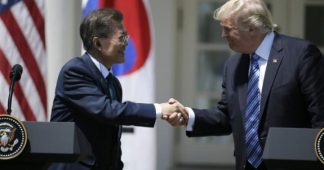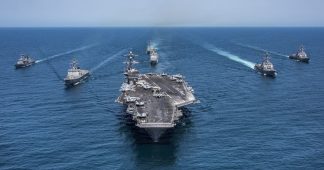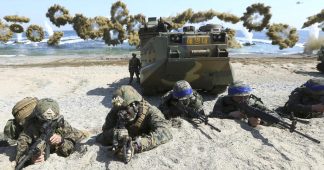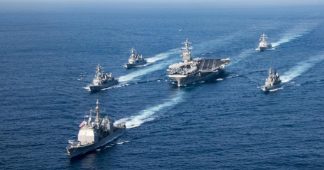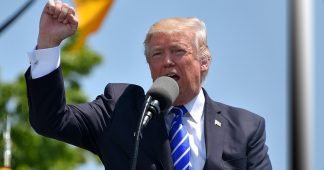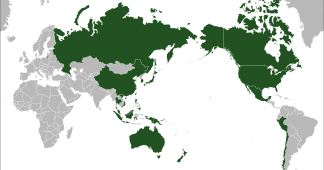By James Cogan
4 November 2017
Donald Trump, accompanied by a coterie of minders and corporate executives, departed yesterday for a 12-day tour of what US foreign policy strategists now officially designate as the “Indo-Pacific.”
This will be one of the longest official trips to Asia ever undertaken by an American president, and its objectives are clear. In the short-term, Washington is seeking to stiffen the backbone of its allies for a catastrophic and potentially nuclear war against North Korea. In the longer term, US imperialism is seeking to maintain its waning global dominance by exerting military and economic pressure on China in order to undermine, and ultimately shatter, its growing influence.
Trump has left the US with his administration mired in disarray and under siege from its political rivals. There is consensus, however, within American ruling circles and both the Republican and Democratic parties, on utilising every means available to prevent China from emerging as a serious challenge to US hegemony. Regime-change in North Korea, on China’s border, is viewed as a means of radically altering the balance of forces in Asia, to the strategic detriment of Beijing.
One of the leading generals in Trump’s cabinet, National Security Advisor H. R. McMaster, bluntly spelled out the message to be delivered to the region. “The president,” McMaster insisted on Thursday, “recognises that we’re running out of time [before a war with North Korea] and will ask all nations to do more.”
Trump will make state visits to Japan, South Korea, China, Vietnam and the Philippines, and attend the Asia Pacific Economic Cooperation (APEC) forum in Vietnam. Capitulating to a torrent of criticism, he has changed his schedule and will stay for at least the first day of the East Asia Summit (EAS), being held this year in the Philippines, November 13–14.
In advance of the tour, the American establishment was so concerned that the US president’s chauvinist and boorish personality could result in a diplomatic disaster, that it insisted he undergo weeks of “briefings”—on everything from whom he will meet; what he can say or tweet; what colour clothing he can wear; and, one suspects, where he cannot put his hands. As one “Washington-based Asia expert” told the Australian Broadcasting Corporation, Trump has been instructed to “just stick with the script.”
Symbolically, Trump’s visit began Friday in Hawaii, with a visit by the president to the Pearl Harbor naval base, where the war between the US and Japan for dominance over Asia began in December 1941. This was preceded by talks with Admiral Harry Harris, the commander of US Pacific Command (PACOM), on the 21st century war being prepared against North Korea. Harris has at his disposal one of the largest US naval armadas ever assembled. Three aircraft carrier battle groups are converging on waters off the Korean Peninsula, along with at least two cruise missile-armed submarines, an undisclosed number of nuclear missile-armed subs, and South Korean, Japanese and Australian warships.
The naval force, along with several hundred aircraft on the carriers, is complemented by B-2, B-1 and B-52 bombers, F-22 stealth fighters, a squadron of F-35 “fifth generation” fighters and hundreds of F-16 fighters and F-18 fighter-bombers, deployed at bases in South Korea, Guam, Japan and Alaska.
If Trump gives Harris the order, he can unleash hundreds of cruise missiles against North Korea in a matter of minutes, followed by wave after wave of air strikes.
On Sunday, Trump is set to arrive in Japan. His daughter Ivanka was dispatched prior to his arrival to hold talks with recently re-elected Prime Minister Shinzo Abe, presumably so the Japanese leader did not have to air controversial issues between the two powers, especially over trade, with Trump himself. The highlight of their interaction will be a game of golf. They will then co-host a meeting with the families of Japanese citizens abducted by the North Korean regime between 1977 and 1983, which will be used in Japan and the US to further demonise Pyongyang and propagandise for war.
Abe’s ultra-nationalist government has given unconditional backing to Trump’s threat to “totally destroy” North Korea, despite massive popular opposition in Japan to militarism and war. Abe has also fully aligned Japan imperialism, in its own self-interest, with the US preparations for confrontation and war with China, initiated in 2011 with the Obama administration’s “pivot to Asia.”
On November 7, Trump will arrive in South Korea, where the population faces the prospect of hundreds of thousands of deaths and ruination if the United States provokes war on the peninsula. He will deliver a speech to the country’s National Assembly, which is expected to focus on the necessity for South Korea to support US plans to attack North Korea, on the pretext of preventing the impoverished country from developing its limited nuclear arsenal.
The venality of the South Korean ruling elite is underscored by its acceptance of the US military taking full command over its own armed forces as soon as hostilities begin.
On November 8, Trump will travel to Beijing. His meeting with Chinese President Xi Jinping has reportedly generated the most nervousness among his minders. While ahead of the talks both governments have issued statements referring to the strength of their relations, the true state of affairs is one of ever-growing tension and sources of conflict.
Trump’s task, for which numerous American strategists consider him woefully inadequate, is to advance the demands of US imperialism that China make far-reaching strategic and economic concessions.
He will insist, firstly, that Xi and his regime stand aside in the event of war with North Korea, a country with which China has a formal military alliance. Secondly, Trump is expected to stipulate that Beijing accepts the pro-imperialist United Nations court ruling of 2016, which rejected its territorial claims over islets and reefs in the South China Sea. Finally, he will table demands for greater access to the domestic Chinese market for American and other transnational corporations.
From China, Trump will proceed to Vietnam, where the Asia-Pacific Economic Cooperation (APEC) forum is convening on November 10 in the city of Da Nang. The Vietnamese regime has increasingly aligned itself with Washington against Beijing, and reportedly intends to bestow extravagant state honours on the US president.
Whether Trump will use the occasion of APEC to hold talks with Russian President Vladimir Putin, who will be there, is not yet clear. Beset by accusations that his election victory was the outcome of “Russian interference,” a meeting between Trump and Putin could be explosive, particularly given Moscow’s vocal opposition to any military action against North Korea.
From Vietnam, Trump will travel to the Philippines, where he will participate in an official state meeting with the country’s fascistic president, Rodrigo Duterte. The White House has brushed aside concerns over Duterte’s reign of terror and his agenda of murdering thousands of people in the name of a “war on drugs.” Anything is acceptable to the American ruling class providing the Philippines continues to serve as a frontline US client state. Under Obama and now under Trump, the US has used Manila’s territorial disputes with Beijing in the South China Sea as one of the justifications for its military build-up in the region.
Whilst in the Philippines, Trump has scheduled meetings with Malcolm Turnbull, the prime minister of Australia, and Jacinda Ardern, the newly elected Prime Minister of New Zealand.
Australia is considered by the US strategic and military establishment as a critical ally in the preparations for, and waging of, a war with China. The country serves as one of the most vocal supporters of American foreign policy internationally, hosts key US military facilities, and has dispatched naval forces to join the US fleet that is gathering off the Korean Peninsula. New Zealand is likewise a member of the “Five Eyes” intelligence alliance and hosts significant US spying bases. Ardern and her right-wing Labour coalition government have signalled that they will align more closely with the US against China.
The APEC talks and East Asia Summit will bring into stark focus the dilemma confronting every Asian state, as China’s economic weight continues to expand and the global role of the United States continues to decline.
Beijing is offering participation in its multi-billion-dollar “One Belt One Road” projects, aimed at developing energy and transport links between East Asia and Europe.
Donald Trump, the personification of the degeneration and decay of American imperialism, is offering ultimatums to China and the region that they accept the destruction of North Korea and the economic dictates of his administration, or face the prospect of nuclear war.
